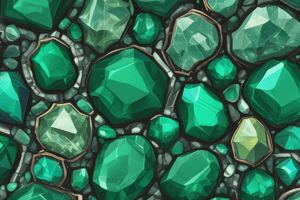Podcast
Questions and Answers
What is the Mohs scale range of emeralds?
What is the Mohs scale range of emeralds?
- 6.5 to 7.5
- 7.5 to 8 (correct)
- 8 to 9
- 9 to 10
What is the ideal color range of emeralds?
What is the ideal color range of emeralds?
- Greenish blue to blue
- Yellowish to greenish
- Reddish to pinkish
- Bluish green to green (correct)
What is the primary source of emeralds?
What is the primary source of emeralds?
- Igneous rock environments
- Metamorphic rock environments (correct)
- Sedimentary rock environments
- Hydrothermal rock environments
What is the characteristic crystal structure of emeralds?
What is the characteristic crystal structure of emeralds?
What is the phenomenon that occurs when the cutter orients the table perpendicular to the crystal's length?
What is the phenomenon that occurs when the cutter orients the table perpendicular to the crystal's length?
What is a characteristic inclusion pattern found in some Colombian emeralds?
What is a characteristic inclusion pattern found in some Colombian emeralds?
What is the term used to describe the finest emerald color?
What is the term used to describe the finest emerald color?
Which emerald cut allows for minimum carat loss?
Which emerald cut allows for minimum carat loss?
What is the primary method used to synthesize emerald crystals?
What is the primary method used to synthesize emerald crystals?
What is the term used to describe inclusions in emeralds?
What is the term used to describe inclusions in emeralds?
Which of the following countries is NOT a significant source of emeralds?
Which of the following countries is NOT a significant source of emeralds?
What is the name of the largest and most productive emerald mine in Zambia?
What is the name of the largest and most productive emerald mine in Zambia?
Flashcards are hidden until you start studying
Study Notes
Emerald Characteristics
- Mohs scale hardness: 7.5 to 8
- Emerald is a variety of beryl
- Most prized emeralds are highly transparent, with colors ranging from bluish green to green, and strong to vivid saturation
- Iron content affects the color, with lower iron content producing a purer green color
Chemical Composition
- Emerald is composed of beryllium, aluminum, silicon, oxygen, and one or more of the trace elements chromium, vanadium, and iron
Forming Source
- Emeralds are formed in metamorphic-rock environments, where pegmatites intersect with schists (e.g. Brazil)
- They can also occur in sedimentary rock environments, associated with hydrothermal veins (e.g. Colombia)
Crystal Structure
- Emerald crystal structure is an elongated six-sided prism
Phenomena and Characteristics
- Dichroism: a phenomenon that occurs when the cutter orients the table perpendicular to the crystal's length, resulting in a prized bluish green color
- Clarity characteristics: color zoning, fractures, liquid and multiphase inclusions, mineral crystals, needles, and growth tubes
- Trapiche emerald: a type of emerald with dark inclusions that extend from the center of the crystal, forming a pattern that looks like the spokes of a wheel
- "Oil-drop effect": a phenomenon that occurs in the finest Colombian emeralds, producing a roiled pattern similar to honey or oil
Treatments and Cuts
- Common treatments: oiling or fracture filling, dyeing
- Common cuts: emerald cut, round, oval, pear, marquise, or heart shapes, in brilliant, step, or mixed-cut facet arrangements
- Calibrated sizes: 5x3 mm through 7x5 mm range, with calibrated rounds available in sizes below 4 mm
Trade Names and Countries of Origin
- "Colombian" is commonly used to describe the finest emerald color
- "Zambian" is often used to describe emeralds that are slightly darker and more bluish than Colombian emeralds
- "Jardin" is used to describe inclusions
- Countries of origin: Colombia, Zambia, Brazil, Afghanistan, Pakistan, Russia, Zimbabwe, Madagascar, and China
Synthetic Process
- Flux and hydrothermal are the main synthetic processes used to produce emeralds, with hydrothermal being the primary method
- Jacques Joseph Ebelman was the first to use the flux process to synthesize emerald crystals, and Johann Lechleitner synthesized emerald hydrothermally in 1960
Studying That Suits You
Use AI to generate personalized quizzes and flashcards to suit your learning preferences.




